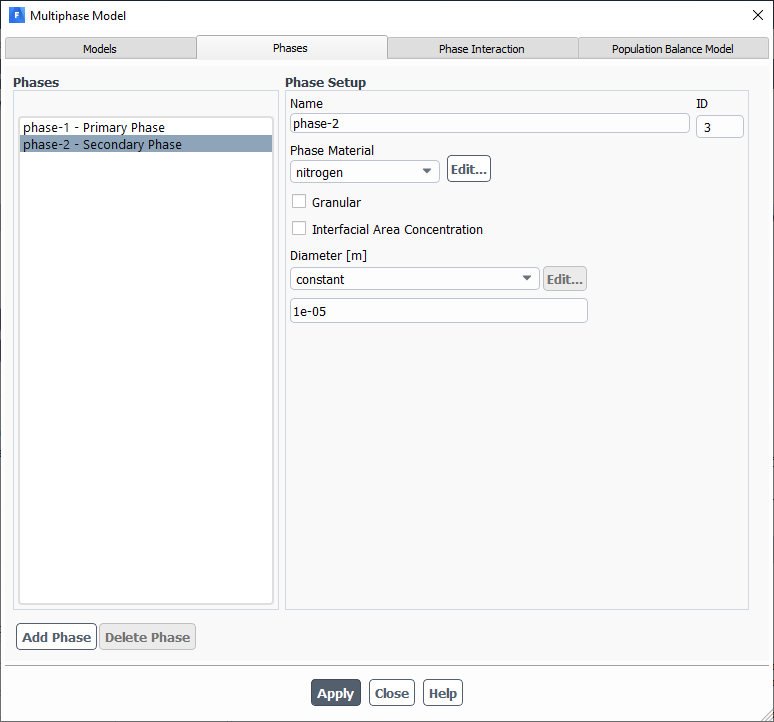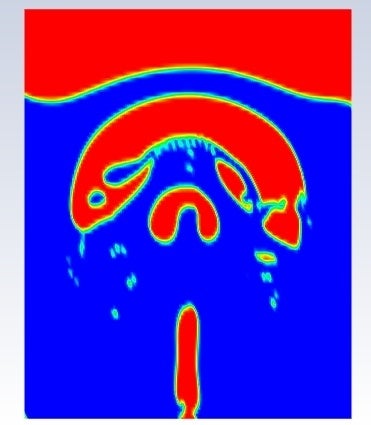TAGGED: ansys-fluent, bubbles, multiphase-flow, vof-model
-
-
May 10, 2021 at 2:30 pm
Deepak_296
SubscriberI want to simulate bubble formation in a container partially(3/4th) filled with water. Gas injection through a hole in the bottom. This needs to be a 2D case. Can I do Multiphase ---> Eulerian----> Multi-Fluid VOF model?
May 10, 2021 at 3:32 pmRob
Forum ModeratorYou can. You probably want sharp/dispersed but I'll let you read up for why.
May 11, 2021 at 7:18 amDeepak_296
SubscriberWhat is the equivalent of Max face size in Ansys 2020 R1 meshing? This option isn't there in 2020 R1. I'm following a tutorial but it's for an older version
May 11, 2021 at 9:32 amRob
Forum ModeratorCan't remember without looking, if you look in the Sizing section it's relatively straight forward to switch from old to new.
May 14, 2021 at 5:15 pmDeepak_296
SubscriberThanks Rob.
For the bubble formation simulation in water, I need to have a gas phase at the top of the water with an interface separating the two phases. I can say the container is 3/4th filled with water. Could you please suggest to me how to get that?
May 17, 2021 at 9:46 amRob
Forum ModeratorIf you mean free surface between the phases look at the Patch function in Fluent. You may also want adaption registers to help. Note, "interface" is often used to specify a change in cell zone so be careful with how you word questions: engineers are nearly all pedants! ;)
May 18, 2021 at 5:22 pmDeepak_296
SubscriberI meant to have a container 80% filled with water having air at the top. I managed to get that using adaptation registers followed by patch to defined the volume fraction of water. However, when I am running the case, it is throwing some "floating point exception error." I am using a 100mm X 80mm water tank with water up to 80mm in height. Air inlet velocity is 0.2m/s from the bottom. Coupled VOF model is used with the k-epsilon turbulence model. The Time step size is 5e-4 and the number of time steps is 1000. Iteration=20/time step size. I am clueless why is it throwing the error. Please help me to fix this.
May 19, 2021 at 3:31 pmRob
Forum ModeratorWith VOF you're fully resolving the bubbles, is your mesh fine enough? How long does it take the flow to cross one cell?
May 19, 2021 at 3:49 pmDeepak_296
SubscriberYes, the mesh is fine enough. Yet I have not calculated the time for the flow to cross one cell. Am I going well with the VOF model? Or do I need to try some other method?
May 20, 2021 at 12:40 pmRob
Forum ModeratorRe the time, work that out, it wants to be about 1/10 to 1/3 of the time step. Re the multiphase model, it depends: read up on the options then think what you want from the results. That's how you decide which model to use.
May 21, 2021 at 9:27 amDeepak_296
SubscriberI want to track the formation of the bubble and their change in shape and size with time. Also the velocity profile of the water around the bubbles. Somewhat I am getting the result but not accurately as bubbles are getting bigger and bigger due to coalescence. Is it possible to define the initial bubble size to be formed due to gas injection?
May 21, 2021 at 11:01 amRob
Forum ModeratorOK, so you will need VOF. Bubbles can be patched into the domain (covered under initialisation). You will need a very good quality and well resolved mesh, small time steps and time.
May 21, 2021 at 11:30 amDeepak_296
SubscriberIf we patch the bubbles into the domain, this implies that the bubbles are already present in the domain. But In my case bubbles should form as a result of the gas injection from the nozzle at the bottom. Is there any way to fix the size of the bubble to be formed due to gas injection only? And how to measure the diameter of the bubble after its formation?
May 21, 2021 at 1:02 pmRob
Forum ModeratorIf you want to set the inlet bubble size you can't use VOF: please read how the various multiphase models work.
May 21, 2021 at 1:21 pmDeepak_296
SubscriberI am using Multiphase---->Eulerian----->Multi-Fluid VOF model. I am able to model bubble formation, coalescence, breaking into smaller bubbles, and bursting at the top of the water surface. But I didn't find any option to set inlet bubble size. Is it possible in this model?
May 21, 2021 at 1:53 pmRob
Forum ModeratorNo, you can set the bubble size in the phase panel. You can also use population balance. However, as you want to see the bubbles growing etc multifluid VOF or VOF are the models to look at.
May 21, 2021 at 2:52 pmDeepak_296
SubscriberThanks Rob for this information. But I am unable to find that in the phase panel. If you can give me some details on how to set the initial bubble size in the phase panel, it would be very much helpful for me.
May 21, 2021 at 3:12 pmMay 22, 2021 at 4:33 pmDeepak_296
SubscriberI tried setting the initial bubble size, but it is giving the same result. Although it is of 1e-5 order, the diameter of the bubble forming first is approximately 1 cm. How is that possible? Am I missing something here?
May 24, 2021 at 8:46 amRob
Forum ModeratorThe bubbles size in the panel is for the Eulerian model. Depending on the flow field and boundary condition you can get anything from a dispersed flow to a stable free surface.
June 1, 2021 at 7:44 pmJune 2, 2021 at 10:33 amRob
Forum ModeratorThat looks pretty good: bubbles tend to deform depending on the velocity, viscosity and surface tension effects.
June 2, 2021 at 4:53 pmDeepak_296
SubscriberYes, bubble deformation will occur depending on the above-mentioned parameter. But the bubble is almost 50 mm in size as the total width of the domain is only 80 mm. How can I get smaller bubbles which are confirmed by the experiments? And how to get plume region?
June 3, 2021 at 1:52 pmRob
Forum ModeratorCheck surface tension etc, is the model 2d or 3d?
June 3, 2021 at 1:58 pmDeepak_96
Subscriber
June 3, 2021 at 2:03 pmDeepak_296
SubscriberIt is a 2D model and I have used the standard surface tension between water and air i.e. 0.072 N/m.
June 3, 2021 at 2:36 pmRob
Forum ModeratorWhich is a 1m deep channel. Is the experiment in a round pipe?
June 3, 2021 at 2:53 pmDeepak_296
SubscriberNo, it is 2D planar (rectangular) model. Dimension is 100 mm X 80 mm. Water is filled upto 80 mm height only and rest 20 mm at the top is air phase. Will the surface tension be different for the dimension I have used?
June 3, 2021 at 3:32 pmRob
Forum ModeratorRead what 2d is defined as in Fluent. How thick is the experimental system?
June 3, 2021 at 5:29 pmDeepak_296
SubscriberYes, the experiment is in a cuboidal vessel. Should that make a difference if I am simulating for 2D model?
June 4, 2021 at 11:34 amRob
Forum ModeratorWhat are the dimensions of the experiment? Ie how "thick" is the domain?
Viewing 30 reply threads- The topic ‘Simulating bubble formation in water container’ is closed to new replies.
Innovation SpaceTrending discussionsTop Contributors-
4858
-
1587
-
1386
-
1242
-
1021
Top Rated Tags© 2026 Copyright ANSYS, Inc. All rights reserved.
Ansys does not support the usage of unauthorized Ansys software. Please visit www.ansys.com to obtain an official distribution.
-













